The Dual Character of MAX Phase Nano-Layered Structure Highlighted by Supersonic Particles Deposition
Abstract
:1. Introduction
2. Materials and Methods
2.1. Materials Used for CS Deposition—Powder and Substrates
2.2. CS Deposition Method—Brief Description
2.3. Characterization Methods
3. Original Results and Discussions on Ti3AlC2 MAX Phase Coating Obtained by CS
3.1. Short Overview of Literature Results
3.2. Ti3AlC2 Powder Characteristics
3.3. Particle Velocity—Wipe Test Relationship
3.4. Coating Microstructure
4. Conclusions
Author Contributions
Funding
Institutional Review Board Statement
Informed Consent Statement
Data Availability Statement
Acknowledgments
Conflicts of Interest
References
- Barsoum, M.W.; Radovic, M. Elastic and mechanical properties of the MAX phases. Annu. Rev. Mater. Res. 2011, 41, 195–227. [Google Scholar] [CrossRef]
- Barsoum, M.W. MAX Phases: Properties of Machinable Ternary Carbides and Nitrides; John Wiley & Sons: Singapore, 2013. [Google Scholar]
- Magnuson, M.; Mattesini, M. Chemical bonding and electronic-structure in MAX phases as viewed by X-ray spectroscopy and density functional theory. Thin Solid Films 2017, 621, 108–130. [Google Scholar] [CrossRef]
- Jeitschko, W.; Nowotny, H.; Benesovsky, F. Kohlen-stoffhaltige ternare verbindungen (H-Phase). Monatsh Chem. 1963, 94, 672–676. [Google Scholar] [CrossRef]
- Drouelle, E.; Brunet, V.; Cormier, J.; Villechaise, P.; Sallot, P.; Naimi, F.; Bernard, F.; Dubois, S. Oxidation resistance of Ti3AlC2 and Ti3Al0.8Sn0.2C2 MAX phases: A comparison. J. Am. Ceram. Soc. 2019, 103, 1270–1280. [Google Scholar] [CrossRef]
- Barsoum, M.W.; El-Raghy, T. Synthesis and characterization of a remarkable ceramic: Ti3SiC2. J. Am. Ceram. Soc. 1996, 79, 1953–1956. [Google Scholar] [CrossRef]
- Low, I.M. Advances in Science and Technology of Mn+1AXn Phases, 1st ed.; Woodhead Publishing: Sawston, UK, 2012. [Google Scholar]
- Wilhelmsson, O.; Palmquist, J.-P.; Nyberg, T.; Jansson, U. Deposition of Ti2AlC and Ti3AlC2 epitaxial film by magnetron sputtering. Appl. Phys. Lett. 2004, 85, 1066–1068. [Google Scholar] [CrossRef]
- Berger, O. The correlation between structure, multifunctional properties and application of PVD MAX phase coatings. Surf. Eng. 2020, 36, 268–302. [Google Scholar] [CrossRef]
- Piechowiak, M.A.; Henon, J.; Durand-Panteix, O.; Etchegoyen, G.; Coudert, V.; Marchet, P.; Rossignol, F. Growth of dense Ti3SiC2 MAX phase films elaborated at room temperature by aerosol deposition method. J. Eur. Ceram. Soc. 2014, 34, 1063–1072. [Google Scholar] [CrossRef]
- Markocsan, N.; Manitsas, D.; Jiang, J.; Björklund, S. MAX-phase coatings produced by thermal spraying. J. Superhard Mater. 2017, 39, 355–364. [Google Scholar] [CrossRef]
- Knight, R.; Barsoum, M.W. Method of Applying Corrosion, Oxidation and/or Wear-Resistant Coatings. U.S. Patent 6,497,922 B2, 4 October 2001. [Google Scholar]
- Sonestedt, M.; Frodelius, J.; Palmquist, J.-P.; Högberg, H.; Hultman, L.; Stiller, K. Microstructure of high velocity oxy-fuel sprayed Ti2AlC coatings. J. Mater. Sci. 2010, 45, 2760–2769. [Google Scholar] [CrossRef]
- Berwyn, S.A.; Strock, C.W.; Sharon, J.A.; Klecka, M.A.; Nardi, A.T. Cold Spray Manufacturing of MAXIMET Composites. U.S. Patent 0230288 A1, 27 April 2016. [Google Scholar]
- Moridi, A.; Hassani-Gangaraj, S.M.; Guagliano, M.; Dao, M. Cold spray coating: Review of material systems and future perspectives. Surf. Eng. 2014, 36, 369–395. [Google Scholar] [CrossRef]
- Gutzmann, H.; Gärtner, F.; Höche, D.; Blawert, C.; Klassen, T. Cold spraying of Ti2AlC MAX-phase coatings. J. Therm. Spray Technol. 2013, 22, 406–412. [Google Scholar] [CrossRef]
- Rech, S.; Surpi, A.; Vezzù, S.; Patelli, A.; Trentin, A.; Glor, J.; Frodelius, J.; Hultman, L.; Eklund, P. Cold-spray deposition of Ti2AlC coatings. Vacuum 2013, 94, 69–73. [Google Scholar] [CrossRef] [Green Version]
- Maier, R.; Garcia-Diaz, B.L.; Hauch, B.; Olson, L.C.; Sindelar, R.L.; Sridharan, K. Cold spray deposition of Ti2AlC coatings for improved nuclear fuel cladding. J. Nucl. Mater. 2015, 466, 712–717. [Google Scholar] [CrossRef]
- Loganathan, A.; Sahu, A.; Rudolf, C.; Zhang, C.; Rengifo, S.; Laha, T.; Boesl, B.; Agarwal, A. Multi-scale tribological and nanomechanical behavior of cold sprayed Ti2AlC MAX phase coating. Surf. Coat. Technol. 2018, 334, 384–393. [Google Scholar] [CrossRef]
- Go, T.; Sohn, Y.J.; Mauer, G.; Vaßen, R.; Gonzalez-Julian, J. Cold spray deposition of Cr2AlC MAX phase for coatings and bond-coat layers. J. Eur. Ceram. Soc. 2019, 39, 860–867. [Google Scholar] [CrossRef]
- Elsenberg, A.; Busato, M.; Gärtner, F.; List, A.; Bruera, A.; Bolelli, G.; Lusvarghi, L.; Klassen, T. Influence of MAX-phase deformability on coating formation by cold spraying. J. Therm. Spray Tech. 2021, 30, 617–642. [Google Scholar] [CrossRef]
- Santos da Silva, F.; Cinca, N.; Dosta, S.; Cano, I.G.; Guilemany, J.M.; Benedetti, A.V. Cold gas spray coatings: Basic principles, corrosion protection and applications. Eclética Quím. J. 2017, 42, 9–32. [Google Scholar] [CrossRef] [Green Version]
- Singh, H.; Sidhu, T.S.; Kalsi, S.B.S.; Karthikeyan, J. Development of cold spray from innovation to emerging future coating technology. J. Braz. Soc. Mech. Sci. Eng. 2013, 35, 231–245. [Google Scholar] [CrossRef]
- Raoelison, R.N.; Verdy, C.; Liao, H. Cold gas dynamic spray additive manufacturing today: Deposit possibilities, technological solutions and viable applications. Mater. Des. 2017, 133, 266–287. [Google Scholar] [CrossRef]
- The, U.S. Develops Soft Biosensor Patch That Can Comprehensively Monitor Vital Signs of Children-a Significant Advancement in Ti3AlC2 Ceramic Material. Available online: https://www.mis-asia.com/news/The-U-S--develops-soft-biosensor-patch-that-can-comprehensively-monitor-vital-signs-of-children-a-significant-advancement-in-Ti3AlC2-Ceramic-Material-150.html (accessed on 23 May 2021).
- Chen, K.; Qiu, N.; Deng, Q.; Kang, M.H.; Yang, H.; Baek, J.U.; Koh, Y.H.; Du, S.; Huang, Q.; Kim, H.E. Cytocompatibility of Ti3AlC2, Ti3SiC2, and Ti2AlN: In vitro tests and first-principles calculations. ACS Biomater. Sci. Eng. 2017, 3, 2293–2301. [Google Scholar] [CrossRef]
- Ng, W.H.K.; Gnanakumar, E.S.; Batyrev, E.; Sharma, S.K.; Pujari, P.K.; Greer, H.F.; Zhou, W.; Sakidja, R.; Rothenberg, G.; Barsoum, M.W.; et al. The Ti3AlC2 MAX phase as an efficient catalyst for oxidative dehydrogenation of n-butane. Angew. Chem. 2018, 130, 1501–1506. [Google Scholar] [CrossRef] [Green Version]
- Koivuluoto, H.; Larjo, J.; Marini, D.; Pulci, G.; Marra, F. Cold-sprayed al6061 coatings: Online spray monitoring and influence of process parameters on coating properties. Coatings 2020, 10, 348. [Google Scholar] [CrossRef] [Green Version]
- Assadi, H.; Gärtner, F.; Stoltenhoff, T.; Kreye, H. Bonding mechanism in cold gas spraying. Acta Mater. 2003, 51, 4379–4394. [Google Scholar] [CrossRef]
- Schmidt, T.; Gärtner, F.; Assadi, H.; Kreye, H. Development of a generalized parameter window for cold spray deposition. Acta Mater. 2006, 54, 729–742. [Google Scholar] [CrossRef]
- Suresh, S.; Lee, S.-W.; Aindow, M.; Brody, H.D.; Champagne, V.K., Jr.; Dongare, A.M. Unraveling the mesoscale evolution of microstructure during supersonic impact of aluminum powder particles. Sci. Rep. 2018, 8, 1–13. [Google Scholar] [CrossRef]
- Bae, G.; Xiong, Y.; Kumar, S.; Kang, K.; Lee, C. General aspects of interface bonding in kinetic sprayed coatings. Acta Mater. 2008, 56, 4858–4868. [Google Scholar] [CrossRef]
- Kliemann, J.O.; Gutzmann, H.; Gärtner, F.; Hübner, H.; Borchers, C.; Klassen, T. Formation of cold-sprayed ceramic titanium dioxide layers on metal surfaces. J. Therm. Spray Technol. 2010, 20, 292–298. [Google Scholar] [CrossRef] [Green Version]
- Schmidt, K.; Buhl, S.; Davoudi, N.; Godard, C.; Merz, R.; Raid, I.; Kerscher, E.; Kopnarski, M.; Müller-Renno, C.; Ripperger, S.; et al. Ti surface modification by cold spraying with TiO2 microparticles. Surf. Coat. Technol. 2017, 309, 749–758. [Google Scholar] [CrossRef]
- Munagala, V.N.V.; Akinyi, V.; Vo, P.; Chromik, R.R. Influence of powder morphology and microstructure on the cold spray and mechanical properties of Ti6Al4V coatings. J. Therm. Spray Technol. 2018, 27, 827–842. [Google Scholar] [CrossRef]
- Wong, W.; Vo, P.; Irissou, E.; Ryabinin, A.N.; Legoux, J.-G.; Yue, S. Effect of particle morphology and size distribution on cold-sprayed pure titanium coatings. J. Therm. Spray Technol. 2013, 22, 1140–1153. [Google Scholar] [CrossRef]
- Walker, M. Microstructure and bonding mechanisms in cold spray coatings. Mater. Sci. Technol. 2018, 34, 2057–2077. [Google Scholar] [CrossRef]
- Park, H.; Kim, J.; Lee, C. Dynamic fragmentation process and fragment microstructure evolution of alumina particles in a vacuum kinetic spraying system. Scr. Mater. 2015, 108, 72–75. [Google Scholar] [CrossRef]
- Palodhi, L.; Singh, H. On the dependence of critical velocity on the material properties during cold spray process. J. Therm. Spray Technol. 2020, 29, 1863–1875. [Google Scholar] [CrossRef]
- Vidaller, M.V.; List, A.; Gaertner, F.; Klassen, T.; Dosta, S.; Guilemany, J.M. Single impact bonding of cold sprayed Ti-6Al-4V powders on different substrates. J. Therm. Spray Technol. 2015, 4, 644–658. [Google Scholar] [CrossRef]
- Goldbaum, D.; Shockley, J.M.; Chromik, R.R.; Rezaeian, A.; Yue, S.; Legoux, J.-G.; Irissou, E. The effect of deposition conditions on adhesion strength of Ti and Ti6Al4V cold spray splats. J. Therm. Spray Technol. 2012, 21, 288–303. [Google Scholar] [CrossRef]
- Gonzalez-Julian, J.; Mauer, G.; Sebold, D.; Mack, D.E.; Vassen, R. Cr2AlC MAX phase as bond coat for thermal barrier coatings: Processing, testing under thermal gradient loading, and future challenges. J. Am.Ceram. Soc. 2020, 103, 2362–2375. [Google Scholar] [CrossRef] [Green Version]
- Bobzin, K.; Lugscheider, E.; Maes, M.; Immich, P.; Bolz, S. Grain size evaluation of pulsed TiAlN nanocomposite coatings for cutting tools. Thin Solid Films 2007, 515, 3681–3684. [Google Scholar] [CrossRef]

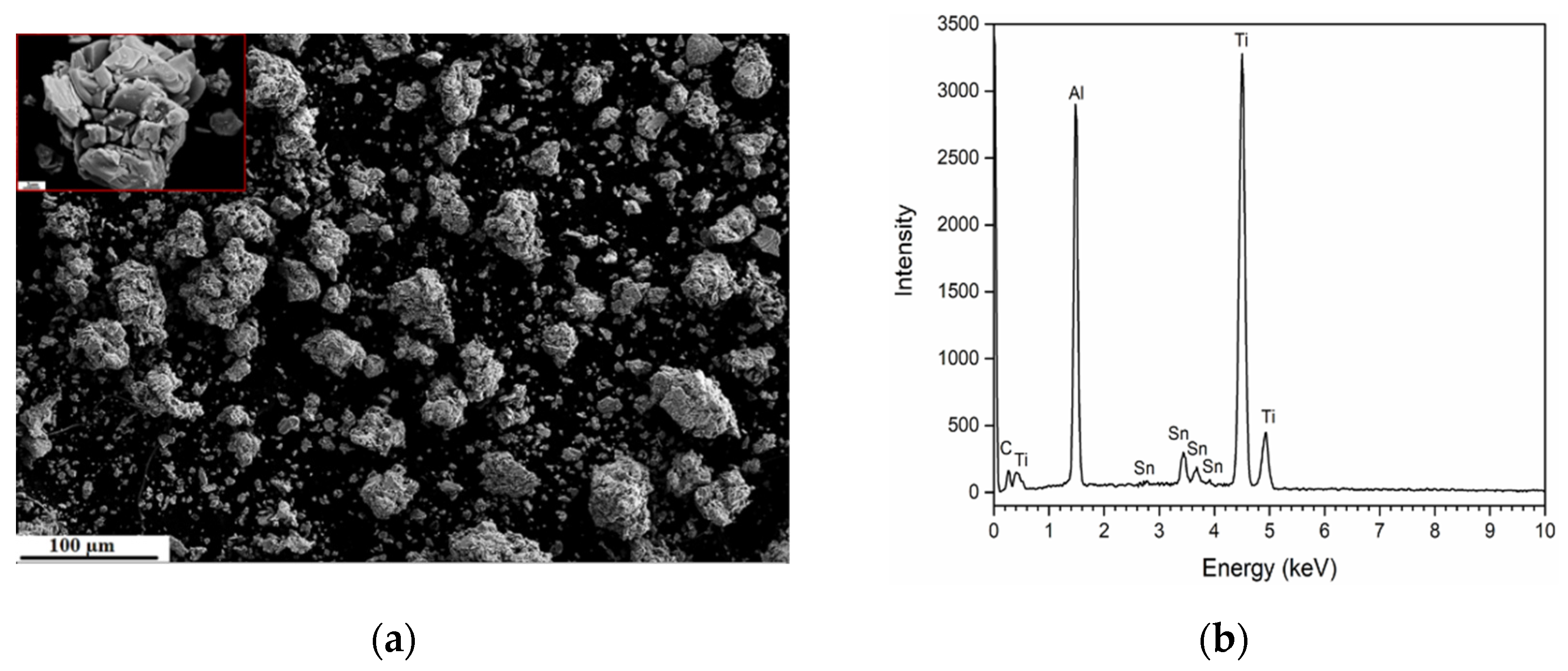
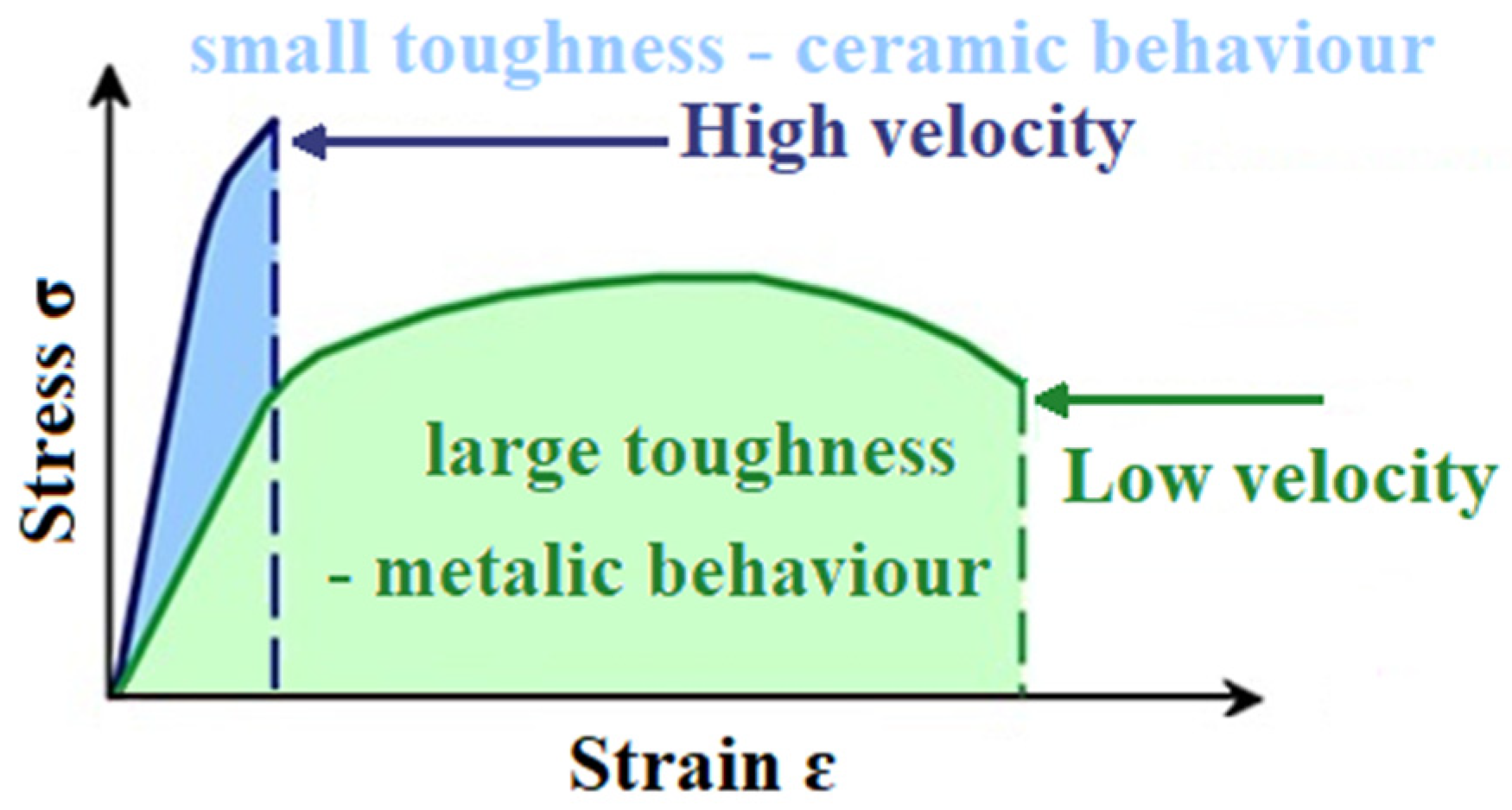
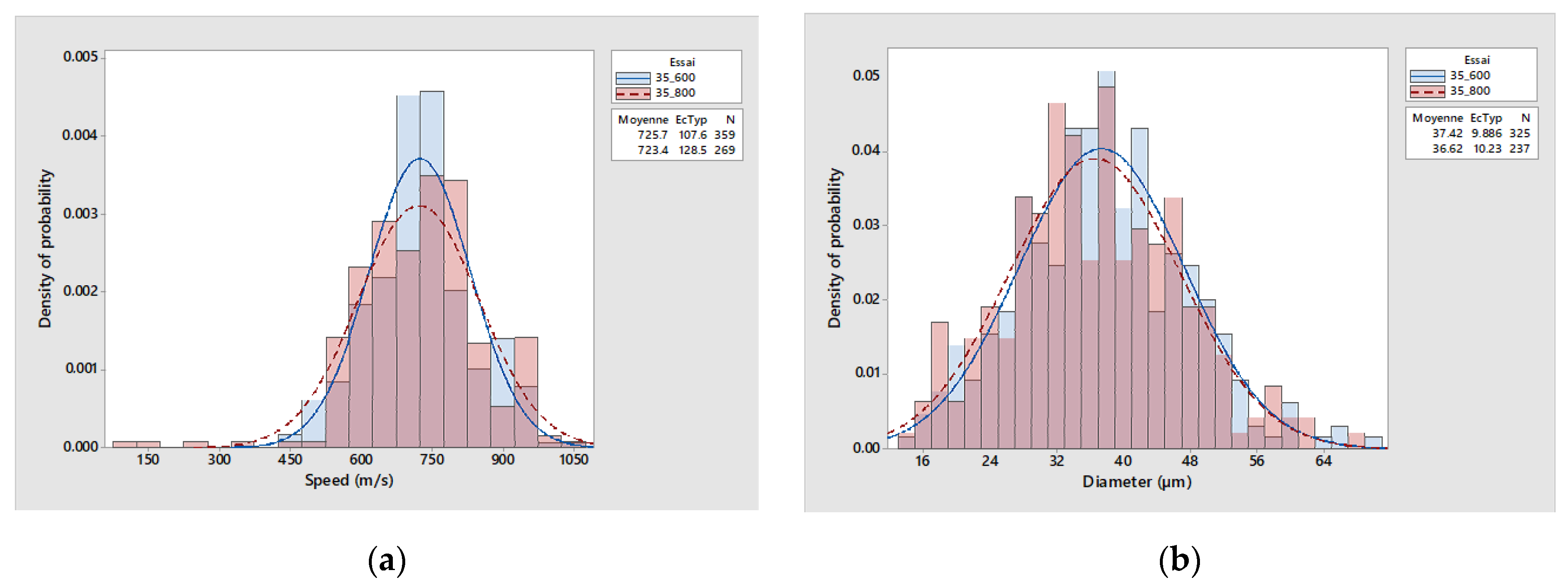
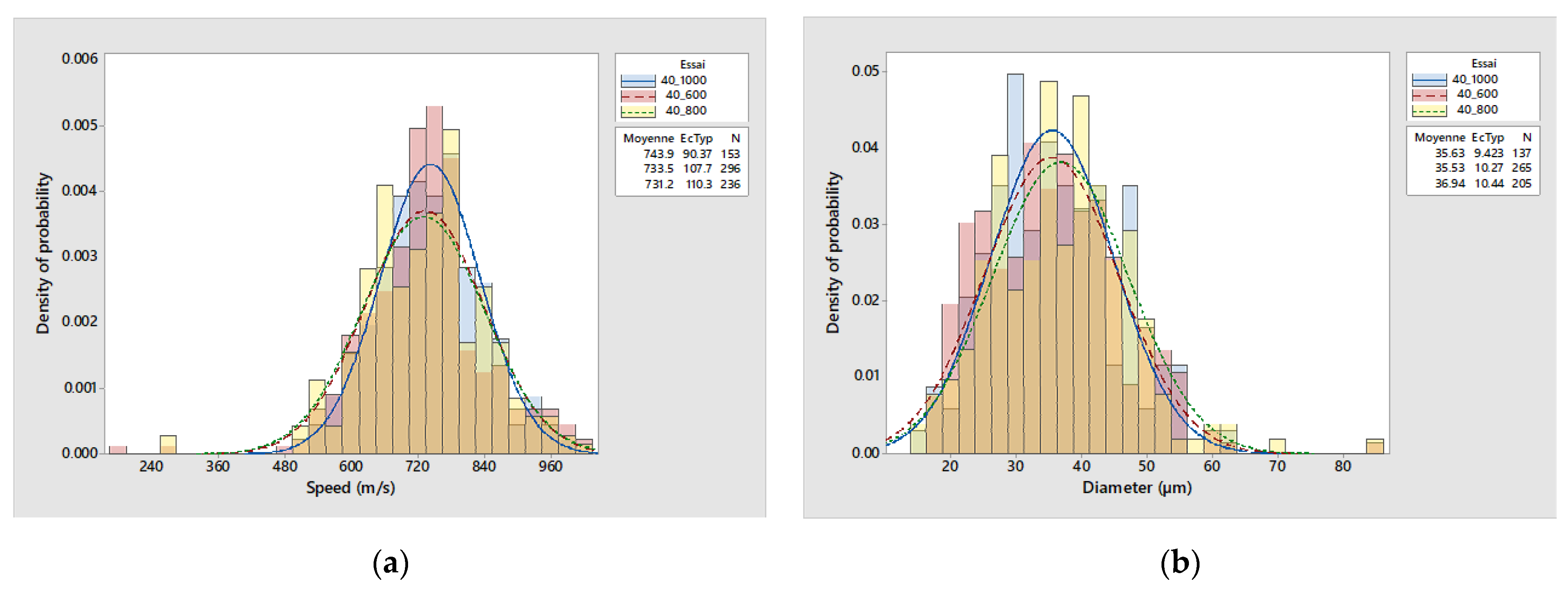
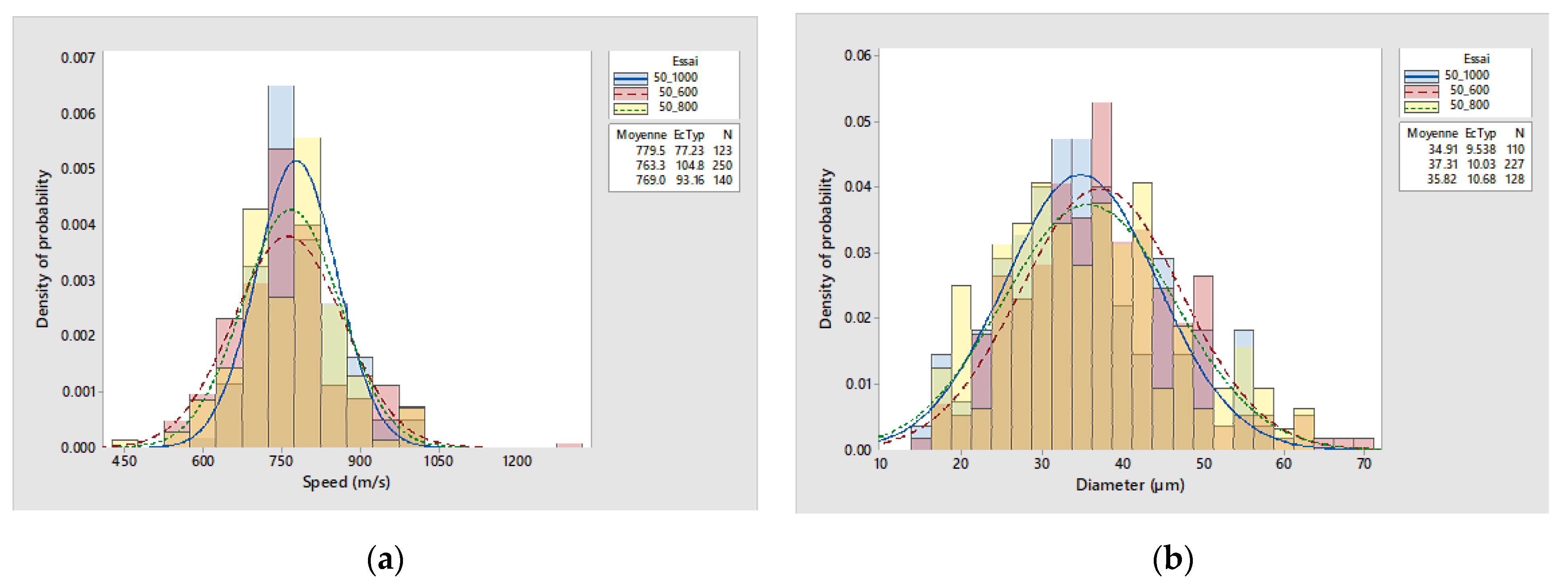


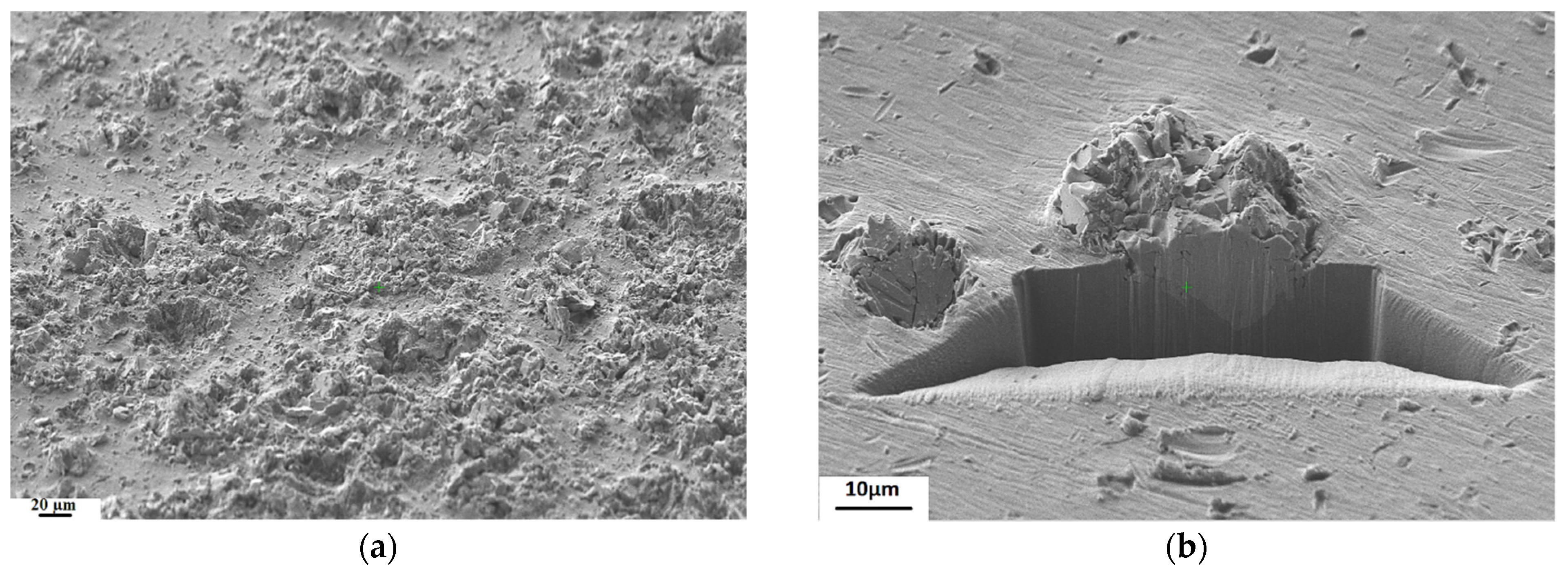
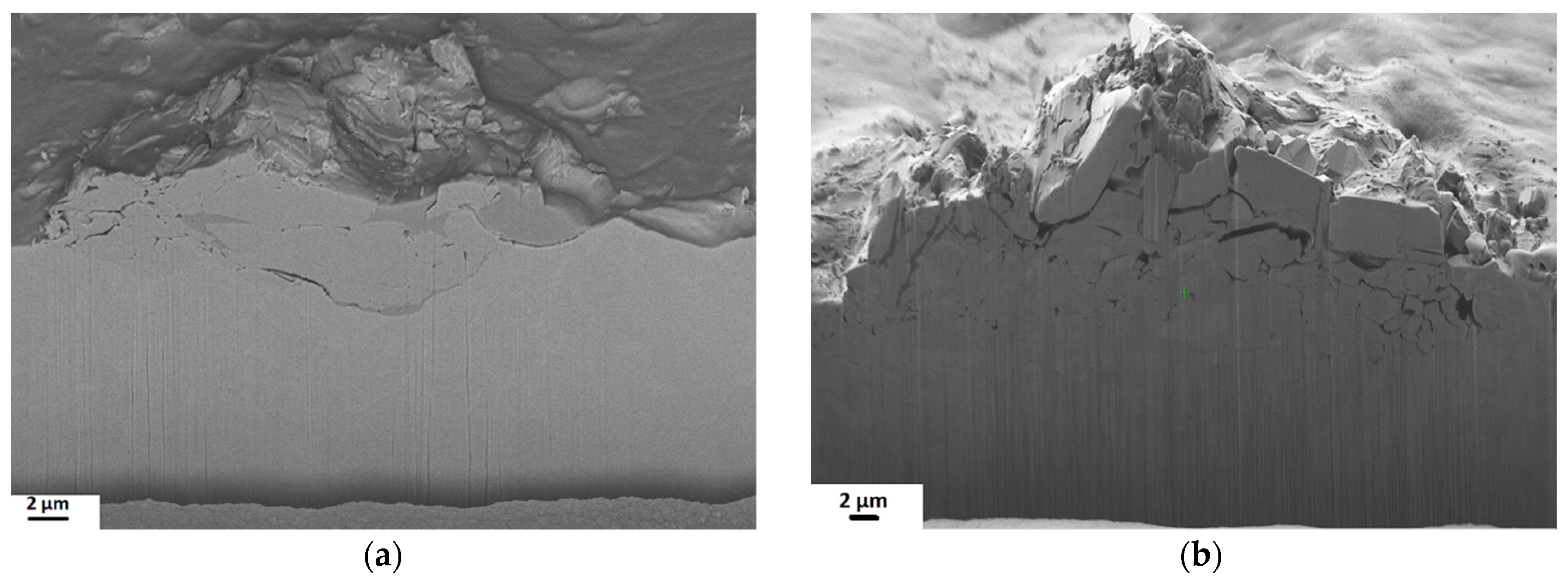
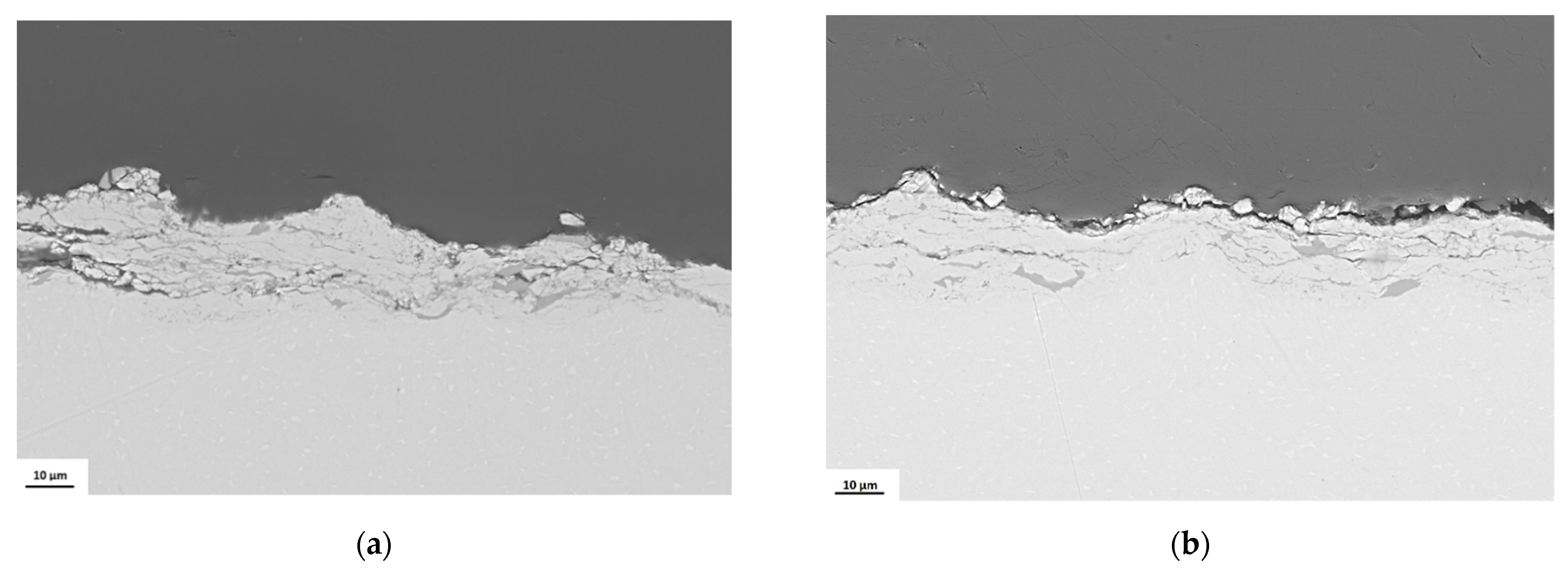



| Substrate/Properties | TA6V | SS | Al |
|---|---|---|---|
| Tensile strength, MPa | 1000 | 515 | 270 |
| Elastic modulus, GPa | 114 | 193 | 70 |
| Yield strength, MPa | 1070 | 332 | 132 |
| Elongation at break, % | 6.7 | 60 | 14 |
| Thermal conductivity, W/m·K | 10 | 15 | 138 |
| Parameter | Value |
|---|---|
| Particle size | (20–40) µm |
| Substrate | TA6V (deposition) SS, Al, TA6V (wipe tests) |
| Process N2 gas pressure | 4 MPa and 5 MPa |
| Process N2 gas temperature | 600, 800, 1000 °C |
| Stand-off distance | 30 mm |
| Transverse speed | 50 mm/s |
| Powder flow rate | 9.3 g/s |
| MAX Phase | Particle Size (µm) | Substrate | Gas Pressure (MPa) | Gas Temperature (°C) | Stand of Distance (mm) | Transverse Speed (mm) | Thickness (µm) | Flow Rate (g/min) | Obs. | Ref. |
|---|---|---|---|---|---|---|---|---|---|---|
| Ti2AlC | 34 (10–63) | Cu Stainless steel | 4 | 600 1000 | 60 | 320 | 110 155 | 24.4 | Enhanced process gas temperatures → higher impact velocities → improve adhesion higher impact temperatures of larger particles → do not play a dominant role. | [16] |
| Ti2AlC | 40 + 25 | Al alloy (Ra~0.5 µm) Stainless steel (Ra~16 µm) | 3.4 3.9 | 600 800 | 20 | 10 50 | 50 80 | 6 | Increasing gas pressure and temperature → increased particles velocity Increasing gas temperature enhances the powder thermal input promoting the growth of cohesive coatings on the hard substrate. | [17] |
| Ti2AlC | <20 | Zr alloy | 3.5 | 600 | - | - | 90 | - | Deformation and compaction effects of the powder due to high-velocity particle impact are observed. | [18] |
| Ti2AlC | - | Inconel 625 | - | - | - | - | 70 | - | Dense coating morphology, no crack/delamination near the substrate-coating interface; but voids characteristic of the inter-splats regions are present in the microstructure. No data about the impact velocity. | [19] |
| Ti2AlC | 63 | Stainless steel | 3.7 | - | 20 | - | 55 | 5-6 | The comparison of the three deposition methods showed that the gas temperature and particle velocity are key factors in coatings characteristics. The CS coatings presented bad inter-locking and were separated by a transversal crack. | [11] |
| Ti2AlC | 2–50 | Stainless steel Cu | 4–5 | 800–1000 | 60 | 100–500 | 300–530 | - | The algorithm linked to the metallic thermal softening approximate the critical velocity to (717–802) m/s. The coatings present low porosity, although they present lateral cracks and local micro-structure inhomogeneities. | [21] |
| Cr2AlC | 2–23 | Stainless steel Cu | 4–5 | 800–1000 | 60 | 100–500 | 200–320 | - | The algorithm linked to the metallic thermal softening approximate the critical velocity to (733–849) m/s. The coating microstructure has two distinct types of morphologies: 50 µm with low porosity layers at the interface, and in the upper part, a more loosely bonded structure with high porosity. | [21] |
| Cr2AlC | 7 | Stainless steel | 4 | 655 750 900 | 60 | - | 40 46 97 | - | Higher gas temperature → higher particle impact velocities and a better cohesion between particles. Therefore, the coatings are thicker and have fewer inter-splat cracks. | [20] |
| Ti3SiC2 | 42 | Stainless steel Cu | 4–5 | 800–1000 | 60 | 100–500 | <45 | - | The algorithm linked to the metallic thermal softening approximate the critical velocity to (699–801 m/s. The coating is not entirely formed, the internal microstructures present lateral cracks. | [21] |
| Parameter | Value |
|---|---|
| Specific Surface Area, m2/g | 0.0758 |
| Real density, g/cm3 | 4.527 |
| Parameter | Value |
|---|---|
| Oxygen, mas.% | 0.0503 ± 0.0145 |
| Nitrogen, mas.% | 0.3907 ± 0.0059 |
| Hydrogen, mas.% | 0.0051 ± 0.0038 |
Publisher’s Note: MDPI stays neutral with regard to jurisdictional claims in published maps and institutional affiliations. |
© 2021 by the authors. Licensee MDPI, Basel, Switzerland. This article is an open access article distributed under the terms and conditions of the Creative Commons Attribution (CC BY) license (https://creativecommons.org/licenses/by/4.0/).
Share and Cite
Ion, A.; Sallot, P.; Badea, V.; Duport, P.; Popescu, C.; Denoirjean, A. The Dual Character of MAX Phase Nano-Layered Structure Highlighted by Supersonic Particles Deposition. Coatings 2021, 11, 1038. https://doi.org/10.3390/coatings11091038
Ion A, Sallot P, Badea V, Duport P, Popescu C, Denoirjean A. The Dual Character of MAX Phase Nano-Layered Structure Highlighted by Supersonic Particles Deposition. Coatings. 2021; 11(9):1038. https://doi.org/10.3390/coatings11091038
Chicago/Turabian StyleIon, Alberto, Pierre Sallot, Victor Badea, Patrice Duport, Camelia Popescu, and Alain Denoirjean. 2021. "The Dual Character of MAX Phase Nano-Layered Structure Highlighted by Supersonic Particles Deposition" Coatings 11, no. 9: 1038. https://doi.org/10.3390/coatings11091038






